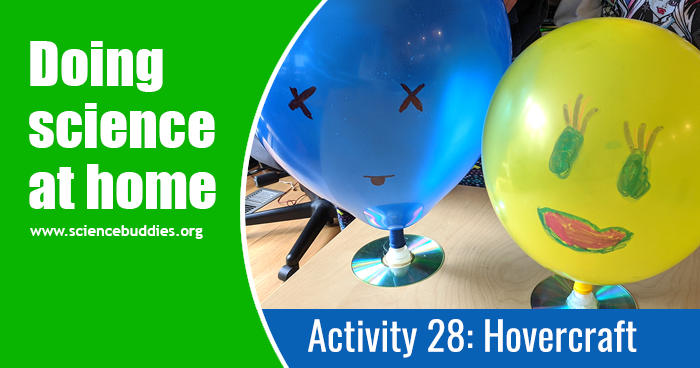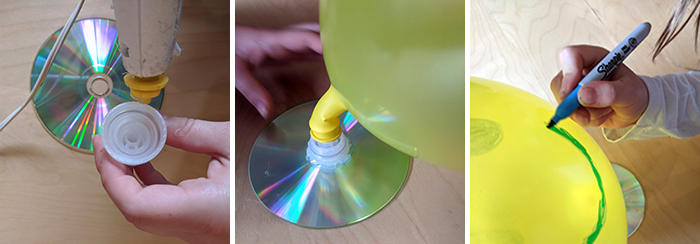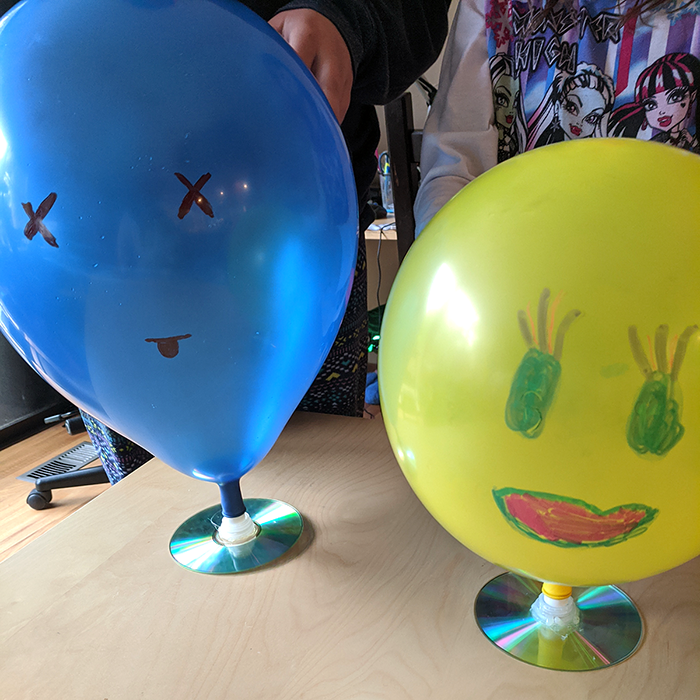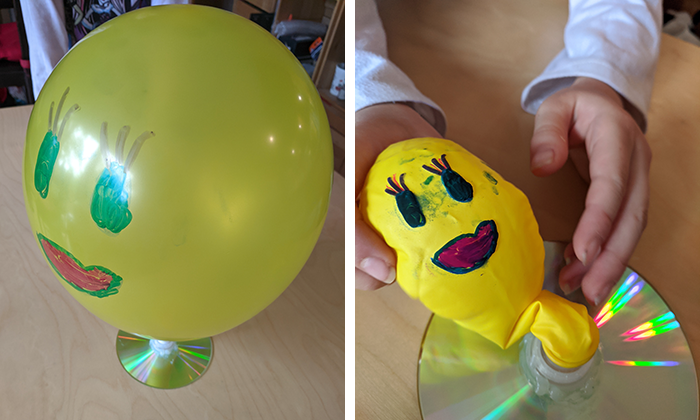Hovercraft: Doing Fun Science at Home during School Closures (Activity #28)
Follow along with a Science Buddies parent who is using family STEM activities to keep her kids learning at home during the COVID-19 school shutdown. New posts every Monday, Wednesday, and Friday. Today's adventure... building balloon hovercraft.

Two homemade hovercrafts made from balloons and CDs and decorated with smiley faces
Balloons + Science = Party Time
Balloons automatically make everything more festive. Whether that's due to their cheerful colors, our cultural associations between balloons and celebrations, or some combination of those or other factors, I don't know. But it's a fact that when the balloons come out, the mood in our house lightens.
This makes balloons a perfect complement for fun learning, and there are a lot of STEM explorations you can do with balloons. There are 14 balloon science projects and activities listed in this roundup, but here are my top five balloon science activity picks for this particular, "still-stuck-in-the-pandemic" time when kids are home from school and increasingly "bored":
- Build a Balloon Car: build a car powered by balloon energy. Extend the fun once you have a working car by making up challenges like how much weight can you add or how far or how fast can the car travel.
- Build a Two-Stage Balloon Rocket: dreaming of getting off this planet? Investigate how a two-stage rocket works and pretend you are traveling to the moon, Mars, or any other space destination.
- How Does a Hovercraft Hover?: experiment with how a balloon provides a cushion of air for this vehicle to float along on.
- Build A Vortex Cannon!: try creating a cannon that expels powerful puffs of air. This one was a kid-pleaser when we made our own air cannons.
- Stretchy Balloon Science: can you poke a skewer through a balloon without popping it? With a bit of science know-how and practice, the answer is "yes!"
My Pick of the Day: Balloon Hovercraft
We were looking for a pop of color and some lighthearted fun to get us going this morning. I didn't want anything too complicated, and I wanted it to be something that the kids could experiment with freely. Having done (and really enjoyed) making balloon air cannons, the obvious choice for me was the How Does a Hovercraft Hover? activity. I bought two pop-top water bottles several weeks ago and tucked them away just for this purpose.
Note: While I'm not a fan of plastic bottles overall, on the rare occasion I do buy them, we use and re-use them for several things. We already used the bottles earlier this week for our elephant toothpaste activity, and I have several more ideas on how we'll continue to use them for other STEM activities.
To my daughter's dismay, there was no video to follow for this activity. She has gotten used to all the activity videos that have gone along with our family science adventures! But, as is true for all of the activities at Science Buddies there were easy-to-follow instructions. Once she got over her minor disappointment about the lack of a video, she had no trouble reading the instructions and following along. It took us less than fifteen minutes to get out our supplies and build our initial hovercraft.
We started by gluing the bottle pop-tops to two old CDs that were scratched up and destined for the trash anyway. While the instructions call for craft or super glue, I opted to try a glue gun because I find it is easy for my children to use and, to be frank, it was handy. The glue gun worked for us as long as the kids were gentle opening and closing their pop-top valves. We did have to re-glue one of the pop-tops after a few rounds of experimenting with our hovercraft, but that was so fast and easy that no one minded.

With the pop-tops glued on, it was time for the tricky part: blowing up the balloons and attaching them to the pop-top without letting out all the air. I found that the best way to do this was to let the kids blow up their balloons, then I would pinch the balloon closed close to the round base, leaving as much balloon neck as possible. The kids would then stretch the balloon neck over the closed pop-top while I kept pinching the balloon closed. We got very good at this method after only a try or two.
Once the balloon is stretched onto the closed pop-top, it will stay inflated. Then, all the kids had to do was open the pop-top and watch their hovercraft zoom along!

Both kids got a kick out of seeing the balloons deflate as the hovercraft zoomed. They did experiment with how the hovercraft behaved if they blew up the balloons to different sizes. This experiment had an unexpected impact on the faces they had drawn on their balloons.
Both kids had decided to make emoji balloons for their hovercraft, a smiley face for my daughter and a dead face for my son. They drew the faces on once the balloons were inflated and on the closed pop-tops. What surprised both of them was what the faces looked like once the balloons had deflated. The ink was so much more concentrated, and the miniaturization of the drawn faces fascinated them. This goes to show that sometimes you start an activity with one science lesson in mind and pick up a few other lessons along the way!

Overall, this activity was a fun success and a great 30-minute exploration to kickstart our day on a good note.
If your kids make hovercraft or do any other balloon STEM activities , we'd love to see. Post a picture of what they make on social media and tag us. You can find us on Twitter, Facebook, and Instagram.
If this blog post was useful to you, please share it with other parents. Follow the links below to see what other science adventures we've been having at home.
View All Posts in this Series
- Activity 1 - Getting Started and Hand Washing
- Activity 2 - Taking Flight with Kites
- Activity 3 - Candle Seesaw and Fire Science
- Activity 4 - Dissecting Flowers
- Activity 5 - Building a Toy Parachute
- Activity 6 - Paper Marbling
- Activity 7 - Shaping Hard-boiled Eggs
- Activity 8 - Invisible Ink
- Activity 9 - Robot Hand
- Activity 10 - Plastic Egg Rockets
- Activity 11 - Rubber Band Guitar
- Activity 12 - Making Model Viruses
- Activity 13 - Air Cannons
- Activity 14 - Balancing an Art Mobile
- Activity 15 - Gumdrop Geometry
- Activity 16 - Solar Updraft Tower
- Activity 17 - Cotton Ball Launcher
- Activity 18 - Wire Water Striders
- Activity 19 - Ice Cream in a Bag
- Activity 20 - Wind-powered Sail Cars
- Activity 21 - Curling Metal
- Activity 22 - Popsicle Stick Catapult
- Activity 23 - Candy Diffusion
- Activity 24 - STEM Videos
- Activity 25 - Making Slime
- Activity 26 - Straw Siphon
- Activity 27 - Elephant Toothpaste
- Activity 28 - Balloon Hovercraft
- Activity 29 - Aluminum Foil Boats
- Activity 30 - Wall Marble Run
A science activity log is available as a Word document or as a Google doc for online convenience. (Just choose "File/Make a copy" to save it to your Google Drive.)
About the Author
Sandra, Science Buddies' Vice President of STEM education, holds a PhD in Genetics from Stanford University and has spent the last twelve years working on science education and STEM outreach. Right now, she's stuck working from her home in the Pacific Northwest with her husband, second grader, middle schooler, and two oddly noisy gerbils. She hypothesizes her sanity will hold as long as she gets a daily dose of sunshine.
Categories:
You Might Also Enjoy These Related Posts:
- Wall Marble Run: Doing Fun Science at Home during School Closures (Activity #30)
- Aluminum Foil Boats: Doing Fun Science at Home during School Closures (Activity #29)
- Hovercraft: Doing Fun Science at Home during School Closures (Activity #28)
- Elephant Toothpaste: Doing Fun Science at Home during School Closures (Activity #27)
- Straw Siphon: Doing Fun Science at Home during School Closures (Activity #26)
- Slime Three Ways: Doing Fun Science at Home during School Closures (Activity #25)
- A STEM Videos Breather: Doing Fun Science at Home during School Closures (Activity #24)
- Candy Experiments: Doing Fun Science at Home during School Closures (Activity #23)









